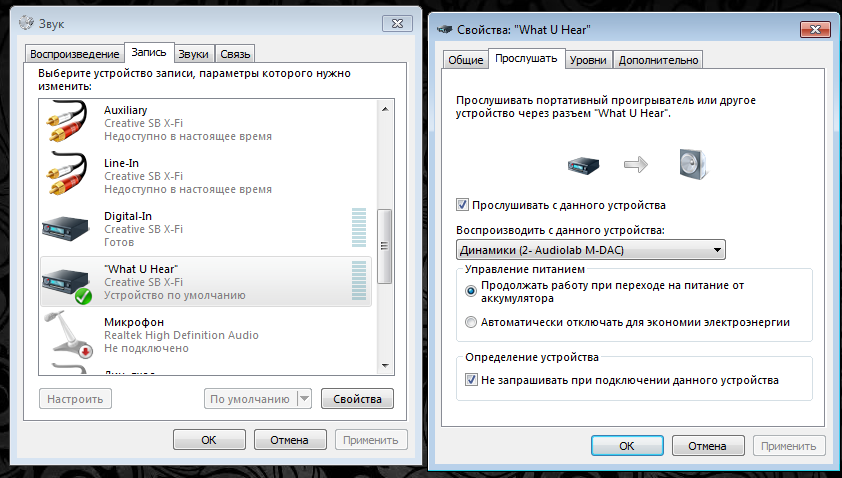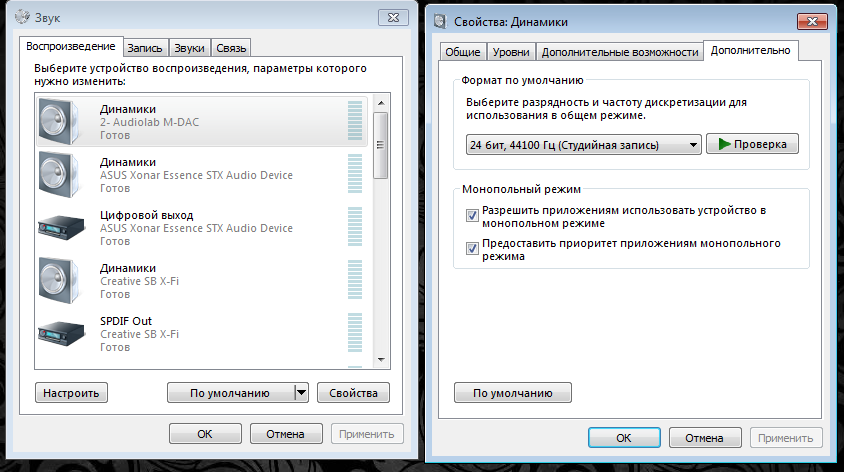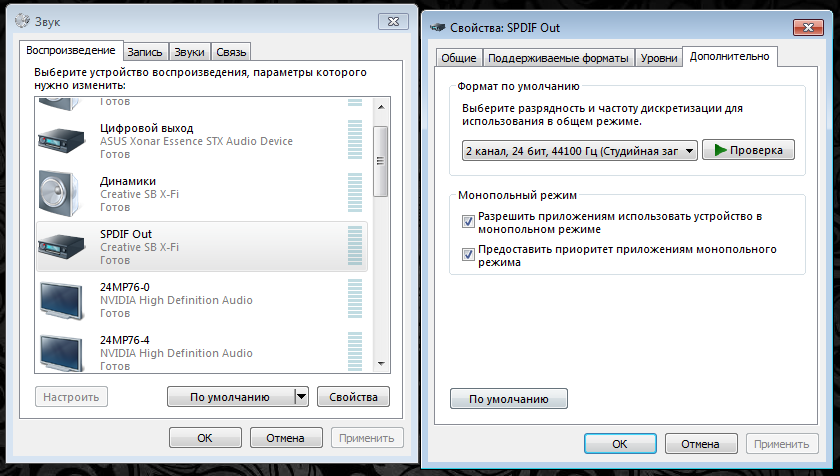Second Life X-Fi - redirecting audio stream wirelessly to a modern sound card

Creative's X-Fi cards were technically the best from the sound processing side of games. Modern cards have a better analog path and at the same time lower-quality sound processing algorithms, which makes it logical to use only DSP from X-Fi and the analog part from a modern card, connecting SPDIF cards. If a modern card does not have an SPDIF input, this does not mean that you need to choose between X-Fi with an outdated analog part and a new card with software processing, since Cards can work together with standard OS tools.
Creative's X-Fi cards were technically the best from the sound processing side of games. After the release of Vista, there were limitations with the implementation of hardware sound. Later, these problems were solved, but the development of sound hardware was almost stopped. New cards from Creative continued to develop in general, and at the same time they pulled up the analog part, but a step back was made for games. Audio processing in X-Fi was preferred because in subsequent versions of maps, this processing has become software.
The ideal option is to use the base X-Fi card with an external high-quality DAC connected via SPDIF. But this option is not for everyone, because An external DAC by itself is by no means cheap or can only have a USB input. More often, there is a desire to add an internal card with a more sophisticated analog part, such as the ASUS Essence STX, Strix DLX, Phoebus or new Creative ZxR or AE-5 cards. Apart from the ZxR, then the cards listed above do not have a digital input, while the ZxR has only an optical input to which a number of X-Fi base cards do not have to be connected without an additional module (the board only has a comb with an electrical SPDIF).
Another option may be to use a modern player with USB-DAC function, from manufacturers such as FiiO, Luxury & Precision, iBasso, Astell & Kern and others.
')
It turns out that in Windows 7 (and possibly 8/10) you can redirect the audio stream without using external software.
For this you need:
Assign X-Fi as default map. Mode set in Game Mode. In the default entry, select What U Hear and activate “listen from device (second card)“. After starting the game, the sound will appear on the output of the selected device!

And what about the quality of transmission? Is the sound stream degrading?
To answer this question, the Reference Audio Analyzer laboratory carried out a rigorous technical test, where there was no place for a subjective impression - “they listened to this and that, and it seems that way and that.”
For the test, an external Audiolab M-DAC DAC was used, which has not only a USB input, but also digital inputs and outputs. At the same time, the digital outputs of the M-DAC in transit went digital flow from the input. Recording from a digital output SPDIF to a digital input was made through a professional card from E-MU. Those. no “analog” with masking noises - only digital stream.
The main task was to identify the presence or absence of the difference in the audio stream:
- with SPDIF X-Fi exit in Audiolab M-DAC
- Redirect audio stream from X-Fi via USB to M-DAC using OS
Additionally, the test was also carried out for 44.1 to the main sampling rate of 48 kHz, since in the settings for X-Fi, the frequency of 44.1 kHz was available for recording and playback, although for Game Mode 44.1 kHz should not be.
The original signal was reproduced via foobar2000 via Wasapi and DirectSound. Mode at X-Fi - Game Mode, all effects are disabled for clarity in the test results. Of course, there will be no Wasapi games, but in general, possible differences could provide interesting information.
results
It turned out that an important condition for the correct transmission of the audio stream is to set the same sampling frequency for the X-fi and the second audio device, otherwise the OS adds unnecessary distortions from the frequency conversion. Moreover, the frequency must be set for both X-Fi "speakers" and X-Fi "digital output".




48 kHz mode

In 48 kHz mode, there is no difference, USB or SPDIF, DirectSound or Wasapi. It was expected that DirectSound will traditionally give worse results, and redirection via USB will throw distortions. But this is not visible. At the same time, the stream is not transmitted in bits per bit, there are minor distortions that are most significant in the dynamic range test. But they are very small. Most likely, this is a consequence of the passage of the stream through the DSP X-Fi. These distortions are not fundamental either, for the reason that they cannot be captured from the analog output, and the only thing that is important with a digital connection is whether USB redirection versus SPDIF is inferior or not.
As a result - no difference, USB or SPDIF!
44 kHz mode

In 44 kHz mode, the result is unexpected. In DirectSound -USB, the result is similar for 48. In the remaining modes, noise in the low-frequency region is slightly added. Those. The regimes for 44 are quite working, but it is better not to abuse them.
Other features
Initially, the USB transfer did not work right away and it was suggested that when reassigning to another card, the system must be rebooted. But it turned out that as soon as the browser page opens with a window from YouTube, the sound is chopped off, and then it can be played only from the YouTube window, although visually everything works. Perhaps with other combinations of programs this effect can be.
From the obvious, in conjunction with X-Fi for the second card, it is desirable to choose modes without effects, like "Direct" for AE-5.
Information about X-Fi and map development
Information does not pretend to historical accuracy and official versions and explanations of events. This is a general presentation of the situation and the arguments in the direction of X-Fi for games against the background of new sound cards.
In the beginning, Creative had quite serious competitors like Aureal 3D and Sensaura 3D, which relied on HRTF filters for surround sound. Creative relied on hardware sound processing with the help of professional DSPs from E-MU. Slowly, Creative bought Aureal 3D and Sensaura 3D. Many perceived it as a banal "elimination of competitors." Unfortunately, the presentation of information was so vague that it was not clear why X-Fi was needed at all for games without EAX support. And the features of the card and the capabilities of EAX were considered only as a set of additional functions directly dependent on the version.
In fact, there were changes in the basic algorithms, which made it possible to get better sound in games without EAX and without the use of add. effects like an equalizer or crystalizer.
One of the problems of the “dirty” sound of Aureal, Sensaura3D and cards from Creative to X-Fi was following the AC'97 standard for simple codecs, which prescribed to operate at 48 kHz. Since most of the samples in the games were from recordings that are multiples of the frequency of 44.1 kHz, non-multiple conversions to 48 kHz greatly worsened the final sound quality.
Aureal did not live up to sound cards with a good analog filling, but Creative Audigy already had a normal DAC on board. But the hardware card did not contain a second generator and could not work at 44.1 kHz.
Alternative cards such as Terratec Aureon Space, Audiotrak Prodigy, M-audio Revolution supported 44.1 kHz, but Sensaura3D algorithms worked only in 48 kHz mode.
The X-Fi processor was much more powerful than the E-MU processor and 90% of its power was directed to a qualitative recalculation of samples from 44.1 to 48 kHz (by analogy with video cards, this is the presence of a good anti-aliasing filter, against poor software implementation). And precisely because of this, X-Fi made it possible to get a clearer sound while continuing to work in a frequency band that is a multiple of 48 kHz.
Those. in games without EAX, but with the calculation of the positioning of the sources X-Fi sounded cleaner than its predecessors. Moreover, the processing algorithms from Sensaura3D (MacroFX and ElevationFilter) were added to X-Fi cards. These effects are not included in EAX, but are used in the basic positioning of sources. These effects were removed (or not added, too lazy to transfer) in the Z and E lines (including the latest AE-5).
The first ASUS cards used Xear3D, the last STRIX and U7 II - A-Volute, which probably work immediately on 44.1 kHz and do not add unnecessary distortion.
Who has the best HRTF algorithms in the end, regardless of EAX, is a separate topic. It is important that by the described method it is possible to take the simplest (inexpensive) card with the necessary algorithms, and reproduce it using the best available device from the user. The source card in the driver is required to have a record of the stream being played. At Creative, this is called “What U Hear”, for ASUS - “Wave”.
When choosing an X-Fi card, you need to pay attention that some models do not contain DSP and use software implementation of algorithms (variations of Xtreme Audio).
Total
You do not need to take the most top-end card for the sake of better sound, like X-Fi Titanium HD or Elite Pro, you just need to take a base card with a hardware X-Fi processor and redirect the sound to a more modern card on a new DAC with a powerful headphone amplifier through the OS. For an ordinary user, this is a more economical option than taking an external DAC with an amplifier and connecting via SPDIF. Data transmission through the OS is not inferior to SPDIF data transmission.
Source: https://habr.com/ru/post/371053/
All Articles